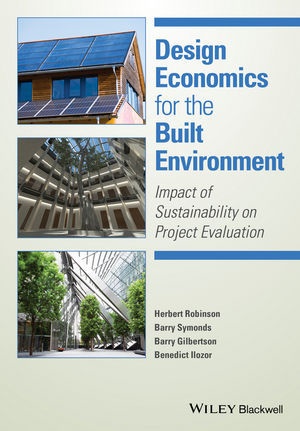Read more
The drive towards environmentally friendly buildings and infrastructure has led to a growing interest in providing design solutions underpinned by the core principles of sustainability to balance economic, social and environmental factors.
List of contents
Editors and Contributors xii
Foreword xxiii
Preface xxv
PART I THEORIES, PRINCIPLES AND APPROACHES 1
1 Economic Context, Policy Environment and the Changing Role of Design Economists 3
Herbert Robinson and Barry Symonds
1.1 Introduction 3
1.2 The economic context 4
1.3 Globalisation of construction market 6
1.4 The policy environment and the construction industry 9
1.5 Current and emerging role of design economists 11
2 Theories and Principles of Design Economics 16
Herbert Robinson and Barry Symonds
2.1 Introduction 16
2.2 Factors affecting design costs and benefits 17
2.3 Capital cost theory 18
2.4 Whole life cost theory 21
2.5 Value management theory 23
2.6 Value of design theory 24
2.7 Carter's model 26
2.8 Resource?]based theory 27
3 New Approaches and Rules of Measurement for Cost Estimating and Planning 31
Barry Symonds, Peter Barnes and Herbert Robinson
3.1 Introduction 31
3.2 The standardisation of cost estimating 32
3.3 The RICS NRM 1 33
3.4 RIBA plan of work, RICS estimating, cost planning and NRM 1 34
3.5 Cost estimating and cost planning 35
3.6 Elemental Standard Form of Cost Analysis (SFCA) 40
3.7 Benchmarking (cost limits) 41
3.8 Building information modelling 43
3.9 Concluding remarks 44
4 The Relationship between Building Height and Construction Costs 47
David Picken and Benedict Ilozor
4.1 Introduction 47
4.2 Research in the 1970s and 1980s 48
4.3 More recent research in Hong Kong and Shanghai 50
4.4 Conclusions 59
5 Appraisal of Design to Determine Viability of Development Schemes 61
Herbert Robinson
5.1 Introduction 61
5.2 Assessing costs and benefits of design alternatives 61
5.3 Appraisal of design using discounting methods 63
5.4 Appraisal of design using residual technique 65
5.5 Case study of the blackfriars development project 69
5.6 Concluding remarks 77
6 Eco-cost Associated with Tall Buildings 80
Peter de Jong and J.W.F. Hans Wamelink
6.1 Introduction 80
6.2 Overview of the Dutch housing market and land use planning 80
6.3 Eco-costs/value ratio and the EVR model 82
6.4 Applying the EVR model to housing 86
6.5 EVR and tall buildings 88
6.6 Embedding EVR in other sustainable ranking methods 89
6.7 Conclusion 90
7 Productivity in Construction Projects 93
Shamil Naoum
7.1 Introduction 93
7.2 Concept and measurement of productivity 94
7.3 Previous literature on factors affecting site productivity 94
7.4 Productivity survey 100
7.5 Proposed framework for site productivity 102
7.6 Conclusion and further research 104
8 Design Variables and Whole-Life Cost Modelling 107
Andrea Pelzeter
8.1 Introduction 107
8.2 Whole-life cost modelling 108
8.3 Steps in LCC modelling 110
8.4 Design principles to optimise lcc 112
8.5 A worked example of an office façade 116
8.6 Inclusion of carbon emissions into wlc modelling 118
8.7 Limitations of wlc 119
8.8 Concluding remarks 119
9 Procurement and Contract Strategy: Risks Allocation and Construction Cost 121
John Adriaanse and Herbert Robinson
9.1 Introduction 121
9.2 Procurement strategy and contract selection 122
9.3 Wembley stadium case study 123
9.4 Allocation of
About the author
The Editors Professor Herbert Robinson, is currently a Regional Adviser and Head of Training Division at the United Nations African Institute for Economic Development and Planning (IDEP), part of United Nations Regional Economic Commission for Africa. He was Professor of Construction Economics at London South Bank University and a Senior Research Associate at Loughborough University, UK.
Barry Symonds,
Senator h.c. Biberach an der Riss, Managing Director of Symonds Konsult International and Associate Director for Rapid5D (BIM Solutions UK). He was the Head of Property, Surveying and Construction at London South Bank University, UK. As a chartered quantity surveyor, he worked as a partner and consultant for practices in the UK and New Zealand. He held academic advisory roles and has been visiting professor, and external examiner in the UK and abroad.
Professor Barry Gilbertson is a Visiting Professor at the University of Northumbria in Newcastle and was a partner at PricewaterhouseCoopers for 15 years. Barry was the first chartered surveyor to become a partner in a firm of chartered accountants, anywhere in the world, and the 123rd President of RICS in 2004/5. Barry was a member of the United Nations Real Estate Advisory Group and a member of the Bank of England's Property Forum.
Professor Benedict D. Ilozor teaches construction management, architecture, facilities planning, design & management at the School of Engineering Technology, Eastern Michigan University, where he is Research & Graduate Assistants Coordinator. He previously taught in Australian universities, and was head of Facilities Management for the Built Environment Research Group at the School of Architecture & Building, Deakin University.
Summary
The drive towards environmentally friendly buildings and infrastructure has led to a growing interest in providing design solutions underpinned by the core principles of sustainability to balance economic, social and environmental factors.

